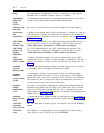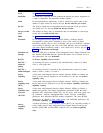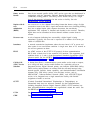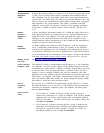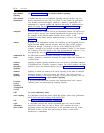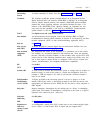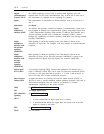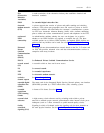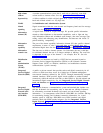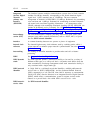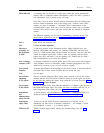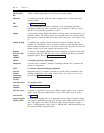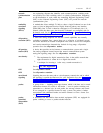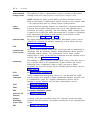
GL-10
GLOSSARY
FRL
final trunk
group
facilities
restriction level
(FRL)
first-choice
trunk group
fixed-loss plan
Flexible
Assignment of
BX.25
(DCIU/SCI)
Signaling Ports
foreign
exchange (FX)
frame
functional
signaling
FX
Generalized
Route Selection
(GRS)
glare
GRS
HDLC
high-level data
link control
(HDLC)
A last-choice trunk group that receives overflow traffic and may receive first-
route traffic. See also trunk group.
An assigned number that determines both the kinds of calls that can be made and
the kinds of facilities (trunks) that can be used when calls are routed via
Automatic Alternate Routing (AAR). See also alternate facilities restriction
level.
The group of trunks on a communications system that is chosen first for a
particular call. See also trunk group.
An end-to-end office-transmission loss plan for the public network in which all
connecting trunks and end offices are digital. For all tandem connections, a
fixed loss of 6 dB is inserted in the receive path of each end office.
A feature that allows ports normally reserved for an application not needed for
that communications system to be used for another application. In the initial
implementation of data-communications interface unit switch communications
interface (DCIU-SCI) signaling ports in System 75 and System 85, certain such
ports were reserved for specific applications. See also BX.25.
A central office (CO) other than the one providing local access to the public
network.
One of several segments of an analog or digital signal that has a repetitive
characteristic. For example, in a time-division multiplexed (TDM) system a
frame is a sequence of time slots, each containing a sample from one of the
channels served by the multiplex system. The frame is repeated at the sampling
rate, and each channel occupies the same sequence position in successive frames.
See also D4 framing format and extended superframe framing format.
See facilities restriction level.
The signaling method used to request specific operations, such as call setup and
call conferencing. See also stimulus signaling.
See foreign exchange.
An enhancement to Automatic Alternate Routing/Automatic Route selection
(AAR/ARS) that performs routing based on call attributes, such as bearer-
capability classes (BCC), in addition to the address and facilities restriction level
(FRL), thus facilitating a Uniform Dial Plan (UDP) that is independent of the
type of call being placed.
The simultaneous seizure of a two-way trunk by two communications systems,
resulting in a standoff.
See Generalized Route Selection.
See high-level data link control.
A standard bit-oriented protocol, developed by the International Standards
Organization (ISO), in which control information is always placed in the same
position and specific bit patterns used for control differ from those used in
representing data, so that errors are less likely to occur.



